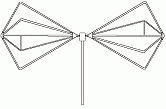Biconical Antenna on:
[Wikipedia]
[Google]
[Amazon]
 In
In 

radio
Radio is the technology of communicating using radio waves. Radio waves are electromagnetic waves of frequency between 3 hertz (Hz) and 300 gigahertz (GHz). They are generated by an electronic device called a transmitter connec ...
systems, a biconical antenna is a broad-bandwidth
Bandwidth commonly refers to:
* Bandwidth (signal processing) or ''analog bandwidth'', ''frequency bandwidth'', or ''radio bandwidth'', a measure of the width of a frequency range
* Bandwidth (computing), the rate of data transfer, bit rate or thr ...
antenna made of two roughly conical conductive objects, nearly touching at their points.
Biconical antennas are broadband dipole antennas, typically exhibiting a bandwidth of three octaves
In music, an octave (: eighth) or perfect octave (sometimes called the diapason) is an interval between two notes, one having twice the frequency of vibration of the other. The octave relationship is a natural phenomenon that has been referr ...
or more. A common subtype is the bowtie antenna, essentially a flattened version of the biconical design which is often used for short-range UHF
Ultra high frequency (UHF) is the ITU designation for radio frequencies in the range between 300 megahertz (MHz) and 3 gigahertz (GHz), also known as the decimetre band as the wavelengths range from one meter to one tenth of a meter ...
television reception. These are also sometimes referred to as butterfly antennas.
Sir Arthur Lodge is the inventor of the biconical antenna.

Properties
The biconical antenna has a broad bandwidth because it is an example of a traveling wave structure; the analysis for a theoretical infinite antenna resembles that of atransmission line
In electrical engineering, a transmission line is a specialized cable or other structure designed to conduct electromagnetic waves in a contained manner. The term applies when the conductors are long enough that the wave nature of the transmis ...
. For an infinite antenna, the characteristic impedance
The characteristic impedance or surge impedance (usually written Z0) of a uniform transmission line is the ratio of the amplitudes of voltage and current of a wave travelling in one direction along the line in the absence of reflections in th ...
at the point of connection is a function of the cone angle only and is independent of the frequency.
Practical antennas have finite length and a definite resonant frequency. A simple conical monopole antenna is a wire approximation of the solid biconical antenna and has increased bandwidth (over a simple monopole).
Applications
Biconical (or "bicon") antennas are often used in electromagnetic interference (EMI) testing either for immunity testing, or emissions testing.
Advantages and drawbacks
While the bicon is very broadband, it exhibits poor transmitting efficiency at frequencies at the low end of its range, resulting in low field strengths when compared to the input power. Log periodic dipole arrays,Yagi–Uda antenna
A Yagi–Uda antenna, or simply Yagi antenna, is a directional antenna consisting of two or more parallel Antenna (radio)#Resonant antennas, resonant antenna elements in an Antenna array#Types, end-fire array; these elements are most often metal ...
s, and reverberation chambers have shown to achieve much higher field strengths for the power input than a simple biconical antenna in an anechoic chamber.
However, when the goal is to fully characterize a modulated or impulse signal, rather than merely measuring peak and average spectrum energy content, a reverberation chamber is a poor choice for a test environment.
See also
* Antenna – general introduction to antennas * Antenna types – broad review of specific antenna types *Bicone
In geometry, a bicone or dicone (from , and Greek: ''di-'', both meaning "two") is the three-dimensional surface of revolution of a rhombus around one of its axes of symmetry. Equivalently, a bicone is the surface created by joining two con ...
– a geometric shape similar to ''one'' of a truncated biconical antenna's arms
* Discone antenna
A discone antenna is a monopole version of a biconical antenna, in which one of the cones is replaced by a disc. It is usually mounted vertically, with the disc at the top and the cone beneath.
Omnidirectional, vertically polarized and wit ...
– a halved biconical – easier to construct and erect than a bicone
* Double cone – the geometric shape of a biconical antenna
* Electromagnetic reverberation chamber – a test environment in which biconicals may be used
* Electromagnetic compatibility – general RF issue, involving testing a device's immunity to radio interference
* Radio transmitter
In electronics and telecommunications, a radio transmitter or just transmitter (often abbreviated as XMTR or TX in technical documents) is an electronic device which produces radio waves with an antenna with the purpose of signal transmissio ...
– devices that benefit from transmitting though a biconical
* Television
Television (TV) is a telecommunication medium for transmitting moving images and sound. Additionally, the term can refer to a physical television set rather than the medium of transmission. Television is a mass medium for advertising, ...
References
External links
* * * {{Authority control Radio frequency antenna types